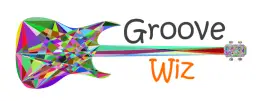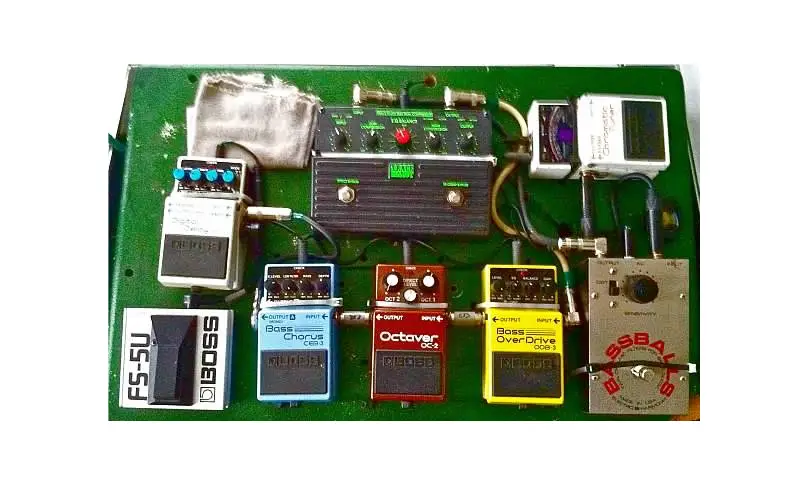In a market flooded with fancy boutique analog pedals and hybrid high-end stompboxes, Boss pedals sit nonchalantly without any frills or fuss. Boss guitar and bass pedals run on 9v, are just the right size, and are built like a tank. They are readily available, easy to modify, and easy to repair. They are affordable to begin with and great value in the used market.
While they may look simple, Boss pedals are built with great attention to detail. The silent FET switches, thick steel casings, recessed knobs, and LEDs are all top-shelf components. The rubberized non-skid bottoms and backlights are as good as they get. Even the battery compartments are super convenient – the panel can be unscrewed by hand to change the battery in a flash.
Pedals like the GE7B, CE-2B, OC-2 and BF-2 have enjoyed the attention of many bass players since the 80s. Boss has set the benchmark in guitar and bass pedals and offers some great utility pedals that sit well in a bassist’s pedalboard.
Few people realize the advantage of having a uniform sized and color-coded pedalboard. One single glance is all you need to tell which Boss pedal does what. And when they say stompbox, you can stomp that box all you want, it will still outlast your career.
When Boss pedals came about, the market wasn’t saturated with as many big brands and boutique pedal makers as there are today. That is probably why Boss pedals have never been about being quirky or flashy looking. Boss’s strategy is to make indestructible units that can last forever and load them with features at affordable prices so people can own as many of them as they need.
Despite the value, functionality and QA, you may once in while bump into a detractor heckling Boss pedals, but they wouldn’t be so pervasive if they weren’t such high-quality units.
Let us take a look at some of the best Boss pedals from the past and present that warrant the attention of effect-hungry bass players.
Table of Contents
Boss OC-2 Octave Pedal
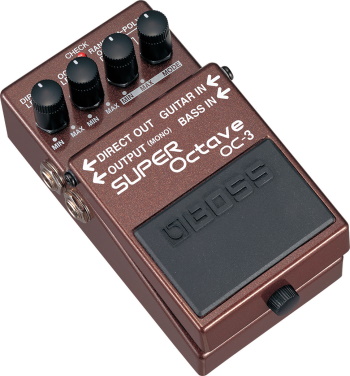
The Boss OC-2 is the GOAT of analog bass octave pedals. It is famous for an inimitable tone – think retro warmth from the 80s. The OC-2 is discontinued and replaced by the OC-3 but you can find one in the used market. If you find a way to mod the pedal, you can get some great synth sounds from it.
So why choose a used Boss OC-2 over the new Boss OC-3 for bass? Well, for one, the OC-3 is digital so there is a small delay when you click-start the pedal. Secondly, the OC-2 costs about 30% less and offers the same note tracking ability. However, OC-3 has poly mode, and even though the tone is less fat (compared to the OC2), it is also less glitchy.
Boss LS-2 (Line Selector Pedal)
The LS-2 is one of the most commonly used blend pedals used by bassists for live performances. It can come in really handy if you use overdrive. The pedal allows you to switch between several devices or amplifiers and you can route the input/output signals as well.
The six looping modes have a lot of practical applications on stage. For instance – you can use the A+B mixed/bypass mode for blending the signal from an effect pedal (like tremolo) with the clean bass signal. Though it isn’t true bypass, there is no noticeable tone suck either.
You can buy new or get a used one for around $50 to 60, which given how sturdy Boss pedals are, shouldn’t be any problem at all.
HF-2 (High Flanger)
The Boss HF-2 is another innocuous Japanese gem that doesn’t get the love it deserves. Unlike the BF-2 flangers, this unit has a more subtle impact on the flange with vivid tone shaping capabilities. It almost sounds like a filtered version of a chorus pedal with lots of chime that would be great for lead tones.
Since it is not as thick or full as a standard flanger, it pairs really well with overdrive and distortion. Though the HF-2 isn’t specially made for bass guitars, it has made its mark on bass pedalboards. There are aftermarket mods available or pre-modded units that can be ordered online at websites like Fromel Electronics.
TU-2 & 3 (Tuner Pedal)
This isn’t exactly a bass specific pedal but every pedalboard needs a reliable tuner and the TU-2 or TU-3 are just that. The tuning is highly accurate (even for low-B strings) and the construction is rock-solid.
Both these variants have exemplary backlighting that is visible even in super-bright daylight. The LED is never going to let you down, no matter how dark it gets on stage. It isn’t fancy in any way, but it is as sturdy and reliable as they get.
Boss CS-1, CS-2, CS-3 (compressor/sustainer)
The CS-1 and CS-2 are currently only available in the used market. The CS-1 had a very different circuit but CS-2 and CS-3 have the same VCA chip with CS-3 having an additional tone knob. Their circuit and sound is similar but the CS-2 seems to have rolled-off highs, which make it sound more fluid and smooth.
Why does CS-2 get more love than the CS-3? The CS-2 is a rugged, no-frills bass compressor unit that sounds warmer and arguably more musical than the CS-3. It is great at producing a squashed tone but without compromising the articulation. Try setting the level-knob to 11:00 and the attack to 12:00 to achieve this effect.
You can also buy a specially modded-version for bass from websites like Humphrey Audio Mods.
Boss AB-2 (2-way selector pedal)
The AB-2 is perfect for bassists who use more than one bass at gigs. It is a straightforward two-in and one-out pedal that allows you to switch between two instruments (or two amps) with a stomp. It doesn’t add any noise and costs $35 new. It works with just about anything and isn’t specifically built for the bass.
Boss CEB-3 Bass Chorus
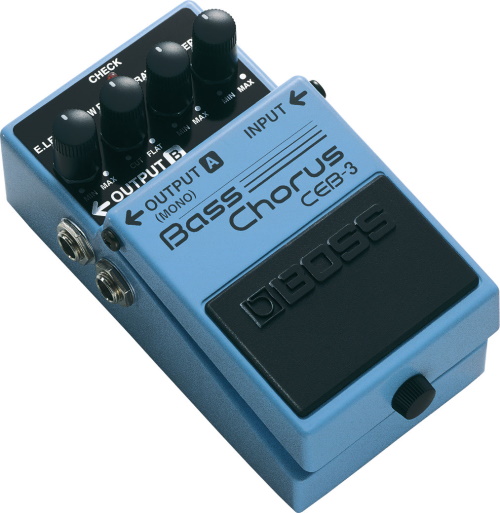
The CEB-3 is another great Boss pedal. It’s essentially the same version as the CE-5 that has been customized for bass guitars with the low roll-off filter. The split-frequency design ensures that you can get some luscious high-end shimmer without muddying up the low-end. Additionally, it sounds amazing with fretless bass guitars.
ODB-3 (Overdrive)
The ODB-3 is from an era when a one-trick pony wasn’t scoffed at. It is a highly underestimated overdrive pedal that is hard to beat at what it was designed to do. It can be a great way to add some low-key grit to your bass tone.
Push it too far and you will begin to hear the strident highs that make some players end up hating it. But it is a classic guitar pedal that can find more bass pedalboard use than units twice the price.
BF-2 and BF-3 Flanger Pedals
When it comes to Boss Bass Flanger pedals, the Japan-made BF-2 is undoubtedly a better unit than the Taiwan-made BF-3. The BF-3 has additional features and flange options but many of them are redundant or will find little to no use in standard play.
On the other hand, the BF-2 offers a significantly better tone that sounds great in rock and metal bass tones. It is lush and flexible and goes for under $50 in the used market. The only reason to opt for the BF-3 would be a need for the Stereo bi-amping option (that the BF-2 lacks).
Boss LM-2B and LMB-3 (Bass Limiter)
If you go hunting in the used market you can find the LM-2B and LM-3B for anything between $30 to $70. They both have identical components and construction but different VCA chips. The LMB-3 is better at peak limiting with a fully variable ratio.
The LMB-2 has a fixed ratio but does a better job at handling big amplitude peaks and offers smoother compression. Either of them can serve a good bass compressor for a ridiculously cheap price.
Boss DD-7 – Digital Delay
The DD-7 is a generic pedal that can fuel some quirky and creative ideas in the hands of a good bassist, especially if you are playing post-rock or ambient stuff. The Delay pedal has up to 3200ms delay and a hold-function which can be used as a looper.
The analog delay and reverse delay modes are exemplary. However, a tap-tempo switch is mandatory with digital delays because the slightest variation in tempo (especially on a bass groove) can quickly make things go sour.
GEB-7 Bass EQ Pedal
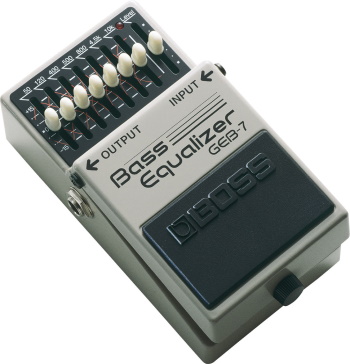
The highly affordable GEB-7 has been a widely popular Bass EQ pedal because it is sturdy, trustworthy and gets the job done. There is no ‘tone suck’ when disengaged and it is simple enough to dial tones on the fly during a concert.
GEB-7’s only competition is the MXR-10 band. Either way, they both have sufficient range to find use as a bass EQ pedal.
Boss GT-6B & 10B (multi effects processor)
If you want to dabble in effects but don’t want to go down the analog pedalboard route, GT-10B is one of the best Multi-FX processors for bass. It is portable, hassle-free, and has great sounds that are usable for recording and live performances.
The GT-10B has all the foot control you will ever need with some bread and butter effects that are great out of the box. It really shines when you learn how to tweak the parameters beyond the factory presets and figure out the right input and output levels for patches.
If you are on a tight budget, you can look for a GT-6B, similar albeit with fewer options, in the used market.
PS-3 &5 (Pitch Shifter)
The Boss Pitch Shifter pedal has enjoyed a fair share of fame in the category. The unit has 10 modes – 3 Delay modes, 4 Single PS modes and 3 Dual PS modes.
The most popular sound for the PS is the Mode 8 (Dual pitch Shift), which allows you to use two detune voices simultaneously for a chorus effect. You can also use Mode 9 to mix it up with a detune for one voice and octave up for another voice.
Overall, this is a fun pedal that can find some good creative bass usage if you enjoy the playing of bassists like Jeff Caxide or Chris Wolstenholme.
Boss CE-20
The CE-20 is another generic ‘mothership’ pedal with all the flashing lights and lots of buttons that many bassists use. It has four programmable presets and parameter control for Depth, Brilliance, Ambience, Rate and Level. It also has high and low boost and the usual ‘built-to-last’ metal casing.
This double footswitch unit does demand some pedalboard real-estate but it has a smooth bass chorus and doesn’t ‘tone suck’ on bypass.
Other Boss pedals than work well with bass
For bass players willing to explore analog pedals, a few other Boss pedals that deserve a mention are the PN2 Tremolo, DS-1 Distortion (modded for bass freq.), HM-2 Heavy Metal and the RC-20XL Loopstation (or you can go all out and use the RC-300 like Victor Wooten).
